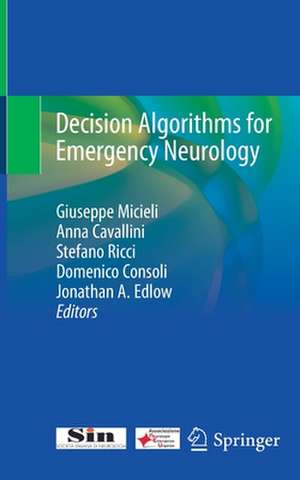Decision Algorithms for Emergency Neurology
Editat de Giuseppe Micieli, Anna Cavallini, Stefano Ricci, Domenico Consoli, Jonathan A. Edlowen Limba Engleză Paperback – 25 noi 2021
This book adopts a novel approach: procedures: instead of discussing the diagnostic categories of neurological syndromes, it focuses on the symptoms of common neurological presentations (especially in the emergency room or on the ward), and the diagnostic hypotheses that can be validated or rejected case by case as a result. Each chapter covers one of the main symptoms of emergencies in neurology – from transient consciousness disturbances to focal deficits, acute muscular disorders, respiratory insufficiency in neurological disorders, headaches, delirium, seizures and epileptic status, para-and tetraplegia, and head trauma, to acute functional disorders – and includes tables and figures to allow readers to gain a quick and easy, yet comprehensive overview of the topic.
The book guides readers through various scenarios generated by the onset of symptoms, the clinical tools for differential diagnostics, and the principles of acute and post-acute phase therapy, managed by decision algorithms supported by the most recent scientific evidence.
The resulting precedural profile – created through the collaboration of over 80 specialists in neurology or other disciplines – makes this text a valuable tool for neurologists, neurology residents and allied professionals in their daily clinical practice, as well as medical students.
| Toate formatele și edițiile | Preț | Express |
|---|---|---|
| Paperback (1) | 669.33 lei 38-44 zile | |
| Springer International Publishing – 25 noi 2021 | 669.33 lei 38-44 zile | |
| Hardback (1) | 1051.55 lei 22-36 zile | |
| Springer International Publishing – 25 noi 2020 | 1051.55 lei 22-36 zile |
Preț: 669.33 lei
Preț vechi: 704.56 lei
-5% Nou
128.12€ • 139.21$ • 107.69£
Carte tipărită la comandă
Livrare economică 16-22 aprilie
Specificații
ISBN-10: 3030512789
Pagini: 624
Ilustrații: XV, 624 p. 254 illus., 252 illus. in color.
Dimensiuni: 127 x 203 x 38 mm
Greutate: 0.69 kg
Ediția:1st ed. 2021
Editura: Springer International Publishing
Colecția Springer
Locul publicării:Cham, Switzerland
Cuprins
Chapter 1. Transient loss of consciousness.- Chapter 2. Coma.- Chapter 3. Delirium /acute confusional state.- Chapter 4. Motor and non-motor epileptic manifestations.- Chapter 5. Headache.- Chapter 6. Fever and neurological signs.- Chapter 7. Acute vision disorders.- Chapter 8. Dizziness.- Chapter 9. Diagnostic algorithm for patients presenting with acute dizziness: the ATTEST method.- Chapter 10. Focal neurological deficits.- Chapter 11. Paraplegia and quadriplegia in the emergency room and in intensive care environment.- Chapter 12. Head injuries.- Chapter 13. Muscle pains, loss of strength and/or sensory disorders.- Chapter 14. Emergencies in movement disorders.- Chapter 15. Airway and respiratory emergencies in neurological disorders.- Chapter 16. Neurological emergencies in pregnancy and puerperium.- Chapter 17. Functional disorders in neurological emergencies.- Chapter 18. Clinical toxicology in emergency neurology.- Chapter 19. Clinical models for neurological emergency.
Notă biografică
Anna Cavallini is currently the Director of the Cerebrovascular Unit of the IRCCS C. Mondino Foundation in Pavia. She co-founded the Italian Associazione Neurologia Emergenza Urgenza (Association of Emergency-Urgency Neurology, ANEU, and was a member of its board from 2015 to 2018, and has been its secretary since 2018. She edited the two last Italian versions (2017, 2019) of Emergency Neurology. Her main clinical and research interests include cerebrovascular diseases and emergency neurology. She has collaborated on numerous scientific projects, in particular concerning clinical and organizational models for the management of acute stroke patients. She is the author of numerous papers.
Stefano Ricci is the former the Head of the Neurological Unit, USLO Umbria 1, where he opened 2 Stroke Units in the hospitals Città di Castello and Branca. He participated in numerous national and international trials, serving as the national coordinator for several them (IST 3, INETRACT 2, ENCHANTED, CLOTS 1 and 2). He is an editor for the Cochrane Stroke Group, and a referee for several journals including Stroke and JNNP.
Domenico Consoli is the former Head of the Neurological Unit, Azzolino Hospital, Vibo Valentia. His main fields of research were cerebrovascular disease and emergency neurology, and he is author of numerous papers on these topics. Vice President of the Italian ANEU, he created and is President of the Hipponion Prize, which is awarded for the best studies conducted by young Italian researchers in the field of cerebrovascular diseases.
Textul de pe ultima copertă
This book adopts a novel approach: procedures: instead of discussing the diagnostic categories of neurological syndromes, it focuses on the symptoms of common neurological presentations (especially in the emergency room or on the ward), and the diagnostic hypotheses that can be validated or rejected case by case as a result. Each chapter covers one of the main symptoms of emergencies in neurology – from transient consciousness disturbances to focal deficits, acute muscular disorders, respiratory insufficiency in neurological disorders, headaches, delirium, seizures and epileptic status, para-and tetraplegia, and head trauma, to acute functional disorders – and includes tables and figures to allow readers to gain a quick and easy, yet comprehensive overview of the topic. The book guides readers through various scenarios generated by the onset of symptoms, the clinical tools for differential diagnostics, and the principles of acute and post-acute phase therapy, managed by decision algorithms supported by the most recent scientific evidence.
The resulting precedural profile – created through the collaboration of over 80 specialists in neurology or other disciplines – makes this text a valuable tool for neurologists, neurology residents and allied professionals in their daily clinical practice, as well as medical students.
Caracteristici
Focuses on the most common neurological presentation symptoms
Includes figures and tables to help explain differential diagnostic and therapeutic approach
Enriched with decisional algorithms
